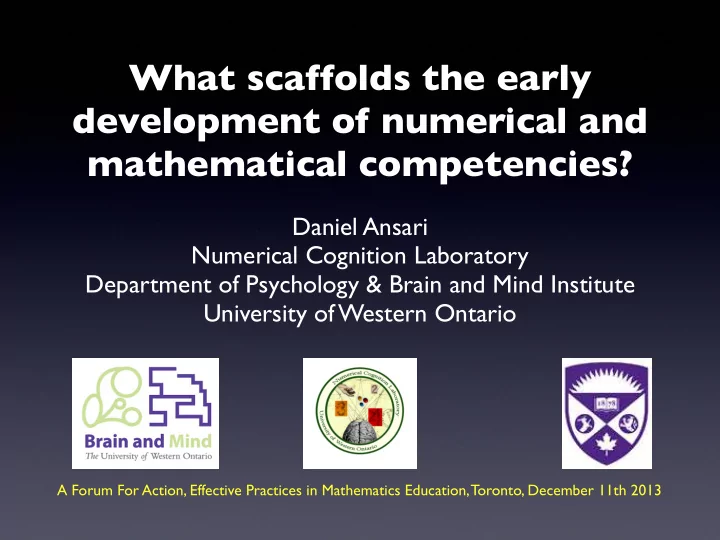

What scaffolds the early development of numerical and mathematical competencies? Daniel Ansari Numerical Cognition Laboratory Department of Psychology & Brain and Mind Institute University of Western Ontario A Forum For Action, Effective Practices in Mathematics Education, Toronto, December 11th 2013
Foundational competencies • What are the early foundations? • What is scaffolding in early development? • Analogy: phonological awareness • Cumulative effect
Foundational competencies Stanovich (1986)
So what might be foundational competencies for numeracy?
Foundational system
Foundational system • Sensitivity to numerical magnitude
Foundational system • Sensitivity to numerical magnitude • Non-symbolic
Foundational system • Sensitivity to numerical magnitude • Non-symbolic • From infancy onwards
Foundational system • Sensitivity to numerical magnitude • Non-symbolic • From infancy onwards • Measurable in other species
Foundational system • Sensitivity to numerical magnitude • Non-symbolic • From infancy onwards • Measurable in other species • Brain systems
Human development 3 Non-symbolic Symbolic non-iconic Iconic Mapping between intuitive and cultural system
Does it matter? • Are the intuitive skills related to children’s math learning? ? • What is the role of integrating symbolic with intuitive (non-symbolic systems)?
Does it matter? Nadia Nosworthy Symbolic Non-symbolic 56 items/condition 1 minute/condition 160, 1st-3rd graders Also tested on: WJ Math fluency WJ Calculation Skils Nosworthy et al. (2013, PLoS ONE )
Does this 2-minute magnitude processing test correlate with math achievement?
Correlation with WJ Math Fluency Nosworthy et al. (2013; PLoS ONE)
Correlation with WJ Calculation Nosworthy et al. (2013; PLoS ONE)
Symbolic counts! • Both symbolic & non-symbolic correlate • But: • Only symbolic accounts for unique variance in arithmetic • over and above working memory, intelligence and reading ability • Processing of number symbols critical • Deficits arise in connecting symbolic with intuitive system ?
Does performance on this test predict performance over time?
Predictive measure?
Predictive measure? • 268 children tested in senior kindergarten on paper and pencil test
Predictive measure? • 268 children tested in senior kindergarten on paper and pencil test • from TDSB NW1 FoS
Predictive measure? • 268 children tested in senior kindergarten on paper and pencil test • from TDSB NW1 FoS • School board permitted access to Grade 1:
Predictive measure? • 268 children tested in senior kindergarten on paper and pencil test • from TDSB NW1 FoS • School board permitted access to Grade 1: • First progress reports
Predictive measure? • 268 children tested in senior kindergarten on paper and pencil test • from TDSB NW1 FoS • School board permitted access to Grade 1: • First progress reports • 2nd term grades
Does performance in SK predict 1st grade teacher-rated performance?
Predictive measure? Progress Report Progressing with difficulty Progressing well Progressing very well Unpublished Data Progressing well
Predictive Measure? 1st term grades Data Number Sense Measurement Geometry Management Symbolic ✔ ✔ ✔ ✔ ✔ ✔ Non-symbolic ✔ indicates significant correlation, p<.05 Unpublished Data
Evidence supports notion of ‘scaffolding’ Calculus Trigonometry Algebra Arithmetic Numerical Magnitude Processing
A developmental perspective
A developmental perspective Lack of understanding numerical magnitude
A developmental perspective Lack of understanding numerical magnitude
A developmental perspective Difficulties in Lack of learning understanding numerical numerical expressions and magnitude maintaining them in memory
A developmental perspective Difficulties in Lack of learning understanding numerical numerical expressions and magnitude maintaining them in memory Developmental time
Website with test & norms forthcoming in Spring 2014
Summary and Conclusions
Summary and Conclusions • Basic numerical magnitude processing
Summary and Conclusions • Basic numerical magnitude processing • Evolutionary history / early development
Summary and Conclusions • Basic numerical magnitude processing • Evolutionary history / early development • Provides an important scaffold
Summary and Conclusions • Basic numerical magnitude processing • Evolutionary history / early development • Provides an important scaffold • By no means the only - one of many
Summary and Conclusions • Basic numerical magnitude processing • Evolutionary history / early development • Provides an important scaffold • By no means the only - one of many • Related to arithmetic skills
Summary and Conclusions • Basic numerical magnitude processing • Evolutionary history / early development • Provides an important scaffold • By no means the only - one of many • Related to arithmetic skills • Particularly symbolic skills
Summary and Conclusions • Basic numerical magnitude processing • Evolutionary history / early development • Provides an important scaffold • By no means the only - one of many • Related to arithmetic skills • Particularly symbolic skills • Intuitive-cultural mapping
Summary and Conclusions • Basic numerical magnitude processing • Evolutionary history / early development • Provides an important scaffold • By no means the only - one of many • Related to arithmetic skills • Particularly symbolic skills • Intuitive-cultural mapping • Strengthening numerical magnitude processing early to enhance dev. trajectory
Thank you for your attention! Funding: Students and collaborators on these projects: Lisa Archibald Annie Appleby (TDSB) Samuel Zheng (TDSB) Stephanie Bugden Bea Goffin Ian Holloway Nadia Nosworthy Gavin Price www.numericalcognition.org
Recommend
More recommend